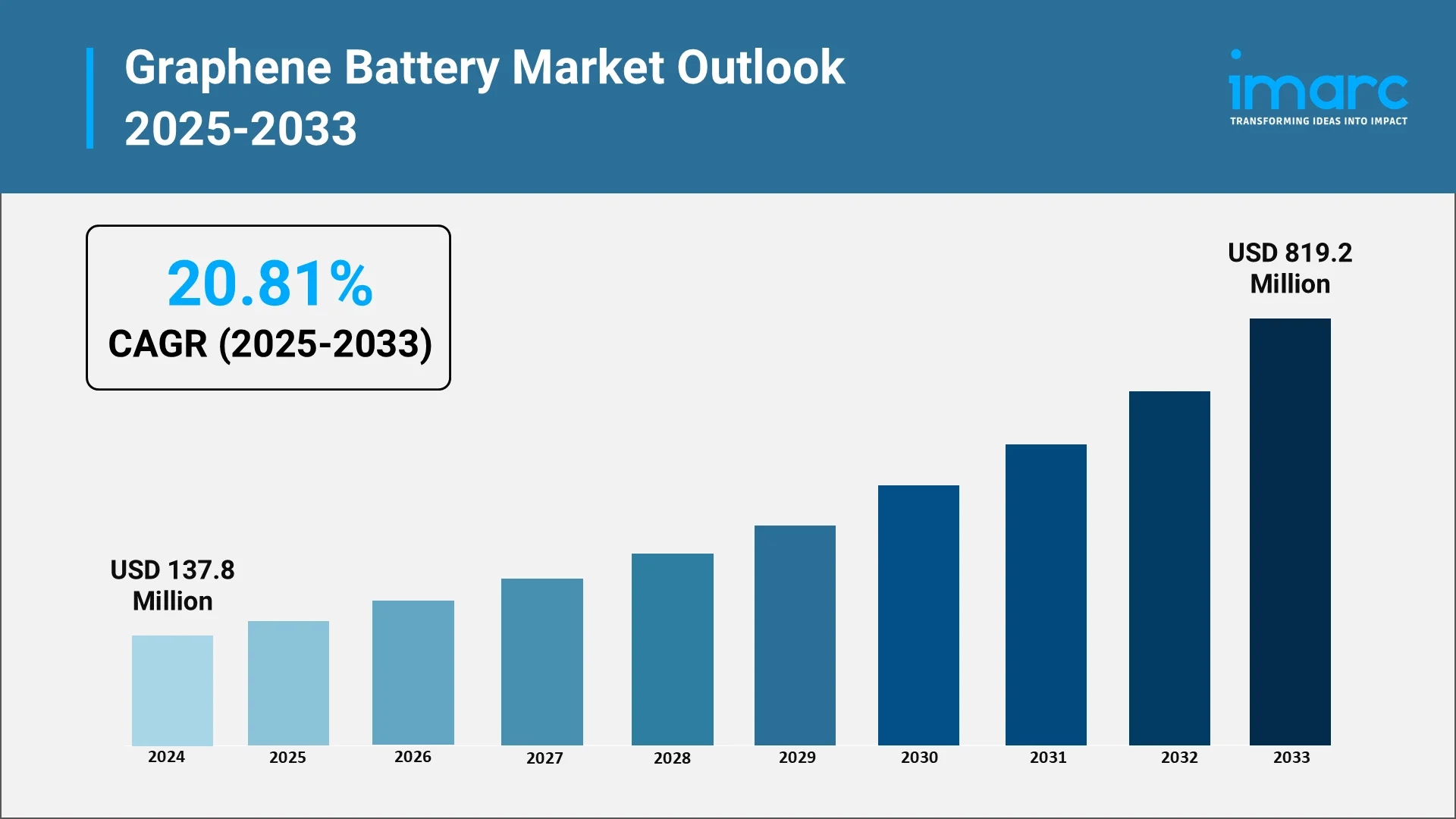How Graphene Batteries are Disrupting Energy Storage Market?
.webp)
Introduction: What Makes Graphene Batteries Revolutionary
The energy storage revolution is here, and it's powered by graphene. While the world struggles with the limitations of conventional lithium-ion batteries, a new technology is emerging that promises to shatter every performance barrier we've accepted as unchangeable.
The global graphene battery market size reached USD 137.8 Million in 2024. Looking forward, IMARC Group expects the market to reach USD 819.2 Million by 2033, exhibiting a growth rate (CAGR) of 20.81% during 2025-2033. Graphene, which is a perfect hexagonal lattice of one layer of carbon atoms, has properties that sound too good to be true. With 200 times the electrical conductivity of copper, 200 times the mechanical strength of steel, and with thermal conductivity higher than in diamond, graphene revolutionizes the underlying physics of energy storage.
In contrast to traditional batteries weighed down by heavy metals and poisonous substances, graphene-based systems represent a quantum leap towards cleaner, greener power storage. The key to the revolution is to tackle the three most serious energy storage challenges that have bedeviled the industry for decades at the same time: charging speed, energy density, and battery lifespan.

Explore in-depth findings for this market, Request Sample
Superior Energy Density and Performance Gains:
The energy density revolution begins with a single, mind-bending statistic: where traditional lithium-ion batteries achieve 150-250 Wh/kg, graphene-enhanced systems can potentially reach 500-1,000 Wh/kg or higher—effectively doubling to quadrupling energy storage capacity while reducing weight.
This performance leap stems from graphene's extraordinary surface area of approximately 2,630 square meters per gram— a single gram of graphene offers a surface area of ~2,630 m², roughly equivalent to one-third of a football field. This vast surface provides unprecedented space for ion storage and movement, enabling rapid charge transfer and higher storage capacity than any conventional electrode material.
Leading graphene battery manufacturer companies report achieving energy densities up to three times higher than traditional lithium-ion systems while maintaining stable performance over extended periods. The implications are staggering: electric vehicles (EVs) could travel 1,000+ miles on a single charge, smartphones could run for days instead of hours, and grid storage systems could store renewable energy with unprecedented efficiency.
Temperature stability adds another performance dimension often overlooked in energy storage discussions. Graphene batteries maintain consistent performance across temperature ranges that would cripple conventional systems, reducing complex cooling requirements and improving overall system efficiency by up to 30%.
Ultra-Fast Charging Capabilities:
Graphene-based systems offer a significant shift in charging time expectations. Graphene batteries can charge 60 times faster than the best lithium-ion cells a capability so revolutionary it fundamentally changes how we interact with battery-powered technology.
The secret lies in graphene's exceptional electrical conductivity and ion mobility characteristics. Traditional batteries suffer from slow ion diffusion bottlenecks that create charging delays and heat generation. Graphene's unique molecular structure eliminates these limitations, allowing ions to move freely across its surface at unprecedented speeds.
Graphene aluminum ion battery technology demonstrates the most remarkable charging performance yet achieved. Research partnerships between companies like GMG, The University of Queensland, and UniQuest have produced systems capable of charging to 80% capacity in under five minutes—compared to 30-60 minutes for conventional lithium-ion batteries.
For electric vehicles, this eliminates range anxiety overnight. Imagine charging your EV in the time it takes to grab a coffee, fundamentally transforming transportation infrastructure and consumer behavior patterns. Graphene-enabled rapid charging may reduce dependence on traditional refueling infrastructure, replaced by rapid charging networks requiring minimal dwell time.
Consumer electronics experience similar transformation. Smartphones, laptops, and wearables could incorporate smaller batteries that recharge within minutes, supporting compact designs and enhanced user convenience.
Grid-scale applications benefit enormously from ultra-fast charging capabilities. Renewable energy systems generating power during brief optimal conditions can rapidly store energy using graphene batteries, maximizing capture efficiency for intermittent sources like solar and wind.
Extended Battery Life and Durability:
Battery replacement costs and electronic waste could become historical concerns thanks to graphene's extraordinary durability characteristics. Independent testing demonstrates graphene battery systems withstanding more than 10,000 charge-discharge cycles without capacity decay—potentially lasting 5-10 times longer than conventional lithium-ion systems.
This translates to decades of service in most applications, fundamentally altering the economics of energy storage Graphene batteries have the potential to deliver extended service life, potentially lasting decades in certain applications, dramatically reducing total cost of ownership and environmental impact.
The durability advantage extends beyond cycle life to mechanical flexibility. Graphene batteries are stable, nontoxic, bendable, and non-flammable—opening possibilities for conformal energy storage in wearable technology, flexible displays, and applications previously impossible with rigid battery designs.
Environmental stress resistance adds another reliability dimension. Graphene batteries demonstrate superior performance under extreme temperatures, humidity, and vibration conditions, making them ideal for aerospace, marine, and industrial applications where conventional batteries fail.
Safety improvements accompany durability enhancements. Traditional lithium-ion batteries risk thermal runaway events leading to fires or explosions. Graphene batteries' non-flammable characteristics and thermal stability significantly reduce these safety risks, enabling deployment in safety-critical applications previously too risky for battery power.
Applications Across Key Sectors: EVs, Electronics, and More
The versatile properties of graphene batteries enable transformative applications across industries, each capitalizing on specific performance advantages that conventional batteries cannot deliver.
- Electric Vehicle Application: The automotive sector represents the largest potential market, where graphene batteries address every critical limitation of current technology. Major companies including Rio Tinto have reportedly expressed confidential interest in working with graphene battery developers across aviation, EVs, diesel engine replacement, rail, energy storage, personal electronics, and power tools.
In March 2025, Graphene Manufacturing Group (GMG) collaborated with the University of Queensland and Rio Tinto to advance Graphene Aluminium-Ion Battery (G+AI Battery) development. GMG has signed a service agreement with the Battery Innovation Center (BIC), Indiana, to leverage its expertise and facilities, avoiding over AU$10M in pilot plant costs. Recent milestones include achieving 1000mAh pouch cells, with readiness expected to advance from BTRL 4 to levels 7–8 through BIC collaboration.
- Consumer Electronics Transformation: Graphene batteries could enable longer-lasting performance in consumer electronics with significantly reduced charging time. The flexibility of graphene batteries enables revolutionary device designs including truly foldable phones, curved displays, and ultra-thin form factors previously constrained by rigid battery limitations.
- Hybrid Energy Systems: Graphene supercapacitor battery systems combine supercapacitor high-power density with battery energy storage capacity. These excel in applications requiring sustained energy delivery and high-power bursts, such as regenerative braking systems, professional power tools, and uninterruptible power supplies.
In November 2023, Melbourne-based startup EnyGy, spun out of Monash University research, launched enyCap and announced the upcoming enyGcap graphene ultracapacitors. Developed over seven years, the technology combines activated carbon electrodes with advanced electrolytes, delivering up to 3V power and double the energy density of current ultracapacitors. Targeted for EVs, renewable energy, and electronics, the products offer wide operating temperatures, recyclability, and cost-saving potential, with full rollout expsected in 2024.
- Aerospace Applications: Weight reduction critically impacts aviation efficiency, and graphene batteries' superior energy density enables lighter aircraft designs with dramatically improved fuel efficiency. Temperature stability and durability make them ideal for harsh aerospace operating conditions.
- Industrial and Grid Storage: Backup power systems, renewable energy storage, and portable equipment benefit from graphene batteries' long cycle life and minimal maintenance requirements. Grid-scale applications could revolutionize renewable energy storage, enabling utilities to manage intermittent power generation with unprecedented efficiency.
In November 2024, HydroGraph Clean Power announced two strategic partnerships to advance graphene-enhanced energy storage. The collaboration with NEI Corporation targets co-branded graphene battery materials for lithium-ion and lithium-silicon applications, while the Volfpack Energy partnership focuses on next-generation supercapacitors, achieving 4× higher capacitance. Lab-scale production starts in Q1 2025, with pilot-scale and global availability to follow, aiming to accelerate adoption of high-performance, sustainable graphene energy solutions worldwide.
Environmental and Sustainability Advantages:
Environmental sustainability drives graphene battery adoption as organizations prioritize eco-friendly technologies addressing climate change concerns. Graphene batteries offer transformative environmental advantages over conventional chemistries.
GMG has developed a proprietary production process to decompose natural gas (methane) into carbon (as graphene), hydrogen, and residual hydrocarbon gases. This provides a lower-impact production pathway compared to mining-intensive lithium-ion processes while generating valuable clean hydrogen byproducts.
- Material Sustainability: Graphene batteries eliminate or significantly reduce toxic and scarce materials common in traditional batteries. Graphene aluminum ion battery systems use aluminum one of Earth's most abundant metals reducing supply chain risks and environmental impact while reducing dependence on cobalt, which is associated with supply chain and ethical sourcing challenges.
- Waste Reduction: Extended lifespan dramatically reduces electronic waste generation. With cycle lives potentially exceeding 10,000 cycles, graphene batteries could last decades, meaning fewer batteries require manufacturing, transportation, and disposal over product lifecycles.
- Recycling Advantages: Graphene's stable carbon structure enables easier recovery and reuse compared to complex lithium-ion chemistries requiring specialized recycling processes. Non-toxic characteristics simplify disposal and recycling procedures, reducing environmental risks associated with battery waste.
- Energy Efficiency: Fast charging capabilities reduce energy losses during charging, while higher energy density requires less material to store equivalent energy amounts. Manufacturing powered by renewable energy could achieve net-negative carbon emissions when accounting for clean hydrogen byproducts.
Market Growth, Challenges, and Future Outlook:
The graphene battery market is experiencing rapid growth momentum driven by technological breakthroughs, increasing investment, and growing demand for high-performance energy storage solutions.
- Investment Acceleration: Major corporations recognize transformative potential, with GMG announcing partnerships with the Battery Innovation Center of Indiana (BIC) to support next-phase development of Graphene Aluminum-Ion Batteries. Such collaborations between technology developers and established industry players indicate growing commercialization confidence.
- Scaling Challenges: Manufacturing scalability remains the primary concern, as current graphene production methods may not support volumes required for mass market applications. Graphene battery manufacturer companies invest heavily in scaling production processes and reducing costs for commercial viability.
- Quality and Standardization: Graphene properties vary significantly depending on production methods, requiring stringent quality control processes ensuring consistent battery performance. Industry standards and testing protocols must develop to support large-scale manufacturing and deployment.
- Cost Reduction Progress: Research demonstrates using low-cost graphene in cathodes enhances charge rates and energy density, cutting lithium-ion battery charging times in half while reducing manufacturing costs by 12%. These simultaneous performance and cost improvements position graphene batteries for accelerated market adoption.
- Future Outlook: Integration with renewable energy systems represents particularly promising growth. As global renewable energy capacity expands, demand for high-performance energy storage systems will accelerate, creating substantial opportunities for graphene battery technology.
The convergence of environmental concerns, performance requirements, and technological advancement creates ideal conditions for graphene battery market expansion. Organizations prioritizing sustainability, performance, and innovation drive early adoption, establishing market momentum for broader commercial deployment.
Looking ahead, graphene batteries represent more than incremental improvement—they promise entirely new applications and business models previously constrained by battery limitations. From electric aviation to grid-scale renewable energy storage, graphene batteries could catalyze transformative changes across the global energy landscape, ushering in an era where energy storage limitations become historical footnotes rather than current constraints.
Insight to Impact: IMARC’s Guide to Transforming the Graphene Battery Market
IMARC Group provides insights for graphene battery manufacturers, investors, and policymakers to navigate the global graphene battery market as advanced material innovations reshape energy storage technology, performance standards, and market competitiveness. Our expertise enables stakeholders to harness graphene for higher energy density, faster charging, longer lifespan, and sustainable growth.
- Market Insights: Explore emerging trends in graphene-enhanced battery chemistries, hybrid supercapacitor systems, ultra-fast charging solutions, grid-scale storage, and electric vehicle applications across the global energy storage landscape.
- Strategic Forecasting: Anticipate market growth, identify segment-specific opportunities, and assess how graphene technology is expected to transform device performance, battery manufacturing efficiency, and renewable energy integration.
- Competitive Intelligence: Track leading graphene battery developers, innovative startups, and R&D hubs pioneering next-generation energy storage solutions and scaling graphene production.
- Policy & Regulatory Analysis: Decode government initiatives, sustainable energy mandates, and global partnerships shaping the adoption of graphene batteries across automotive, consumer electronics, industrial, and grid storage sectors.
- Tailored Consulting: Deliver customized strategies for battery design optimization, manufacturing scale-up, performance enhancement, and commercialization of graphene-based energy storage solutions.
As the graphene battery industry advances, IMARC Group stands as a trusted partner—providing actionable insights to help clients unlock growth, accelerate adoption, and lead in the next generation of energy storage technology.
Our Clients
Contact Us
Have a question or need assistance?
Please complete the form with your inquiry or reach out to us at
Phone Number
+91-120-433-0800+1-201-971-6302
+44-753-714-6104
.webp)










